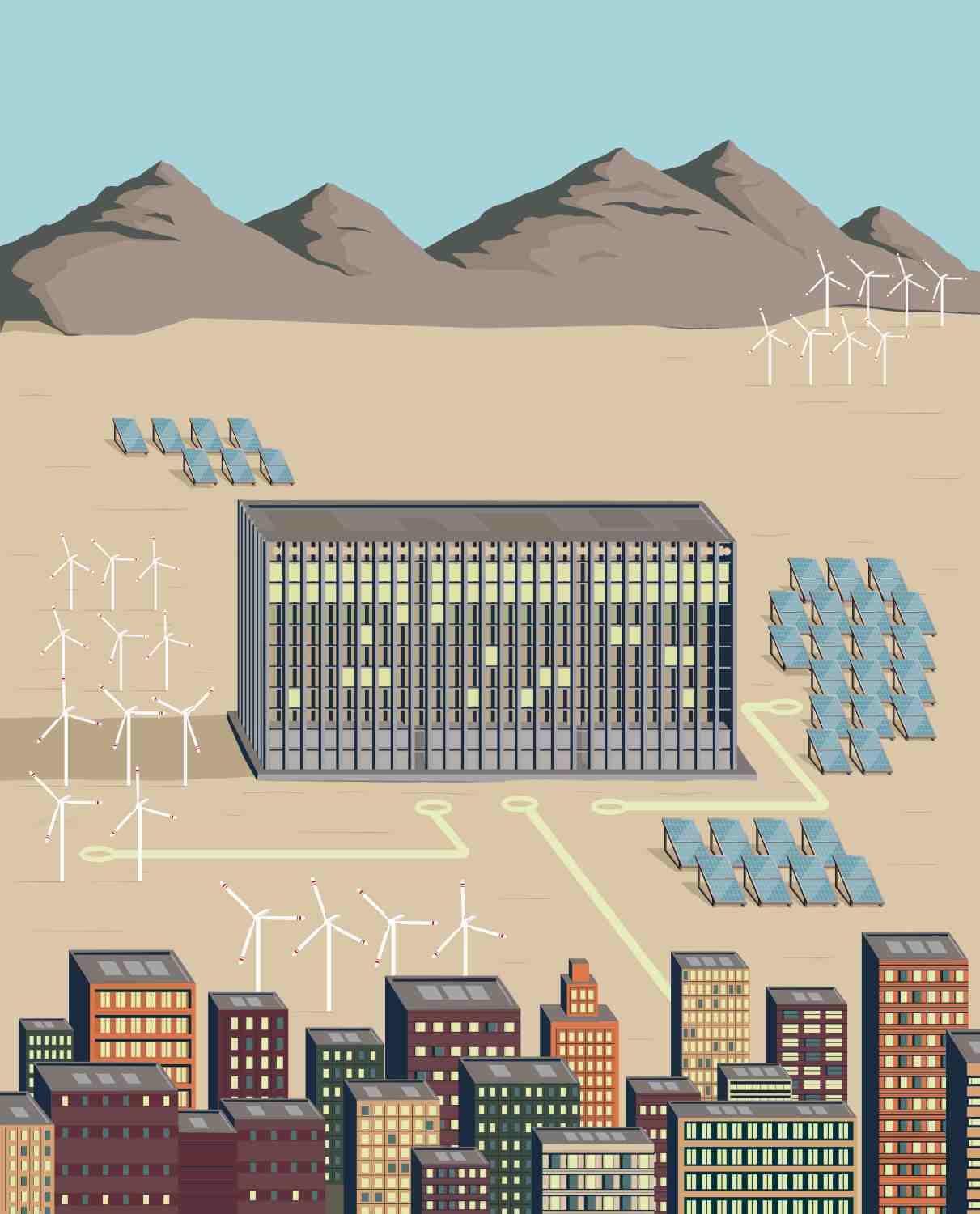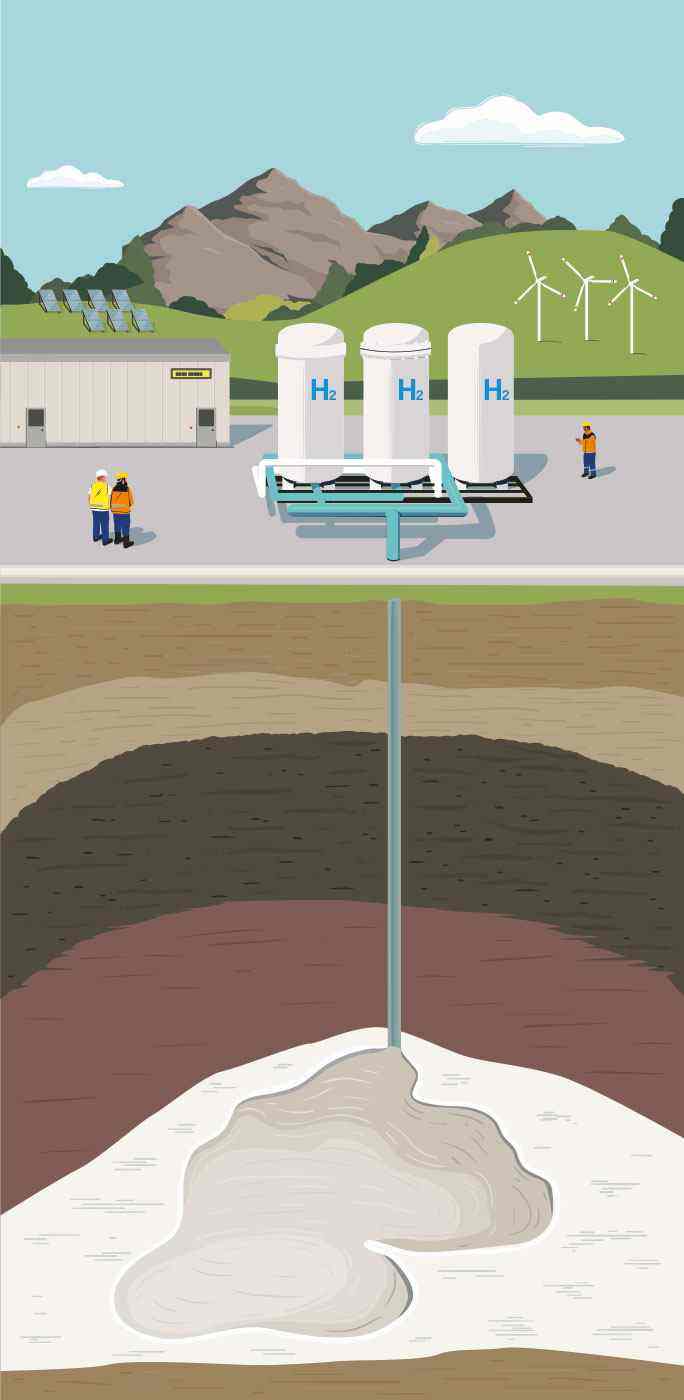Storing Trouble
Illustration by Tracy Worrall
8 min read
Britain leads the world on renewable energy but will fall behind if it doesn’t start building storage capacity to match demand with supply. Chris Chafin finds some surprising options
The bleeding edge of energy storage is surprisingly tactile, even primal. Several world-leading technologies rely alternately on rushing water or dark underground caverns. One company makes a series of gigantic 24-tonne bricks which it hoists into the air and then strategically drops to the earth. It markets this as “a family of gravity energy storage products” and is currently operating a demonstration facility in the Swiss Alps.
Dame Julia King, Baroness Brown of Cambridge, laughs dryly as she calls this last technique “an unbelievably mature technology”. She pauses before adding, “We’ve been doing that for probably thousands of years.”
King is the chair of the Select Committee on Science and Technology in the House of Lords, which is now taking evidence around the question of exactly how these ancient technologies, with some modern twists, will help the United Kingdom meet its target of fully decarbonising its grid by 2050. As it turns out, there’s a lot more to this than replacing coal furnaces with solar farms.
“The sun doesn’t always shine and the wind doesn’t always blow,” said Naomi Baker, senior policy advisor at industry trade association Energy UK, repeating a common phrase in the renewables industry. Though it sounds like a nursery rhyme, the phrase neatly encapsulates one of the most central issues in green energy at national scale.
The reason we currently have consistent power throughout the day and night is that our energy comes from burning substances including coal, natural gas, and oil, which are available around the clock once they’re pulled out of the ground.
“You can’t store wind and solar in a great heap like that,” said King. When it’s dark, or when it’s not windy, renewables simply don’t generate power, full stop. Therefore, there needs to be some way to store the energy they generate for use later.
How much storage? According to a recent report from The Royal Society, “over 1000 times” the amount currently available in the UK, totalling tens of terawatt hours, “far more than could conceivably be provided by conventional batteries”.
Since conventional batteries can’t meet the need, the attention of government and industry has turned to unconventional means of power storage.
With swift action, the UK could become a world-leader in this sector
Take, for example, a process commonly referred to as “pumped hydro”. This technology requires two massive bodies of water at different elevations. When electricity is plentiful, water is pumped from the lower body to the upper one via an electric turbine. When electricity is scarce, the water is allowed to flow back to the lower body through the same turbine, which it spins, generating energy. The first major facility to use this technology, the Engeweiher pumped storage plant in Switzerland, was built in 1907 and has a storage volume of 90,000 cubic meters of water. It’s still in operation today.
Another leading method is hydrogen electrolysis, where hydrogen is separated from water using electricity when it’s available. The hydrogen is then stored for later use in hydrogen generators to pick up the slack during periods when wind and solar aren’t producing power. It takes a lot of energy to compress hydrogen so that it would fit into a tank, which lowers the efficiency of this storage method and increases its cost. Therefore, it’s most common to store the gas uncompressed, which requires huge, airtight spaces. As it turns out, the UK has a ready-made supply of such spaces: salt caverns, thousands of feet below the ground. These are usually cleaned before use by pumping water into them, which dissolves the salt, and then pumping out the resulting brine.
 Illustration by Tracy Worrall
Illustration by Tracy Worrall
“Is there a potential political dimension involving public perception of its safety?” asked Lord Wei, during a recent oral evidence session in the House of Lords on long-duration storage. “Thinking about fracking, although that is a completely different process, would there be environmental concerns that might lead to campaigns that could stop this before it had even begun?”
“My personal view is that there’ll be more concern about stories about the Hindenburg, and it exploding and going up in flames. That will be the kind of thing that stirs up anxiety,” said King when asked about those comments later. In her view these fears are unfounded, though she does say it’s important for the government to do substantial public education before these methods are widely rolled out. “We need the public to be being engaged now in thinking about this, in understanding the benefits of it, in understanding how safe it is, and, giving them a chance to ask all their questions before somebody actually starts trying to do it in their locality.”
One of the principal findings of The Royal Society report is that hydrogen stored in salt caverns is the most likely path forward, something most experts quietly agree with. Aware this is coming, companies with expertise in cave-based gas storage are quietly readying themselves to become a major part of the national energy system. The Second National Infrastructure Assessment, a report from the National Infrastructure Commission (NIC), found that the country will need at least eight terawatt hours (TWh) of hydrogen storage by 2035. It currently has less than one, though it has thousands of TWh of theoretical storage capacity.
Outside of Chesherie, Storengy UK is operation one facility with 20 operational salt caverns 500 meters below ground, each with a capacity of 330,000 cubic meters.
“When we talk to French people, we say you could fit the Arc de Triomphe in each cavern,” said the managing director of Storengy UK, Anne-Laure Chassanite. Though they’re currently using them to store natural gas, the company is keenly aware of their potential future in hydrogen storage, which it is currently actively exploring with the government. “We need to start on energy storage very soon. Setting these facilities up takes a long time.”
This is especially true when thinking cumulatively at national scale. A conservative estimate for how much total storage space the country would need for 8TWh of hydrogen energy is is 64 cubic meters, or roughly 9.7 facilities the size of Storengy's.
There is a nervous optimism in the sector – there is still time to meet targets, but only if the government begins moving forward in the very near future. And given that the current government has shown some flexibility around the intermediate steps between now and 2050, there’s a worry among experts that the timeline may begin to slip. When systems like hydrogen electrolysis and storage will require a full decade to be developed and actually get up and running, there’s an anxiety that the country could fall behind.
“My view is we’re obviously going to build them at some point,” said Liam Hardy, policy analyst for the environmental campaign group Green Alliance. “It’s just a question of when. The longer we wait, not only the more carbon emissions we have to deal with, the more likely we are to fail to meet our legal climate obligations and our international moral obligations.”
Though it’s likely that hydrogen will be the primary long-term energy storage method of choice for the UK, “a wide range of storage technologies deployed at every level from the large scale through to households,” will be needed to truly meet the country’s energy needs, according to Smart Power, another NIC report. Connections to other countries’ power grids, automated systems for shifting when our electric cars recharge, and much more will all become part of everyday life. There’s also, again, more esoteric solutions.
The sun doesn’t always shine and the wind doesn’t always blow
There’s Cheesecake Energy, a Nottingham company making what they’re calling “the world’s greenest battery,” which uses heat and compressed air to store power. The system is relatively small, and “relocatable though not exactly portable,” in the words of CEO, Paul Harris. They see their system as a solution for industries or localities who need some amount of green power as they wait for larger systems to come online.
 Illustration by Tracy Worrall
Illustration by Tracy Worrall
Terraset is a charity launched in 2022 to drive more philanthropic capital into permanent carbon removal, another component of green energy. “According to all realistic climate models, to have any hope of keeping climate change within manageable levels we will need to be removing 5-10 gigatonnes of CO2 from the atmosphere each year by 2050, with scale needed as soon as possible,” said Terraset CEO, Adam Fraser.
“It’s really, we would say, all systems go. We need to be developing them all,” said Baker.
At this point, experts agree, the barriers are primarily political.
“While upgrading the country’s infrastructure is a major task, it is achievable, provided government makes decisions and commits to them for the long term,” reads the NIC’s Second National Infrastructure Assessment.
“I think we would like faster decision making,” said Baker. “I think we’d very much emphasise everything that the National Infrastructure Commission said, which was really about pace rather than perfection.”
There’s also, of course, a case for optimism here. With swift action, the UK could become a world leader in this sector, revitalising its economy with forward-looking green jobs and possibly, under some models, even finding ways to become an exporter of this stored green energy.
There are “lots of opportunities for inward investment if we get the right government policy in place,” said King. “We have done things historically like this over the past [one] hundred years. We’ve made change on this scale. But if we’re going to do it, we’ve got to get on and do it.”
